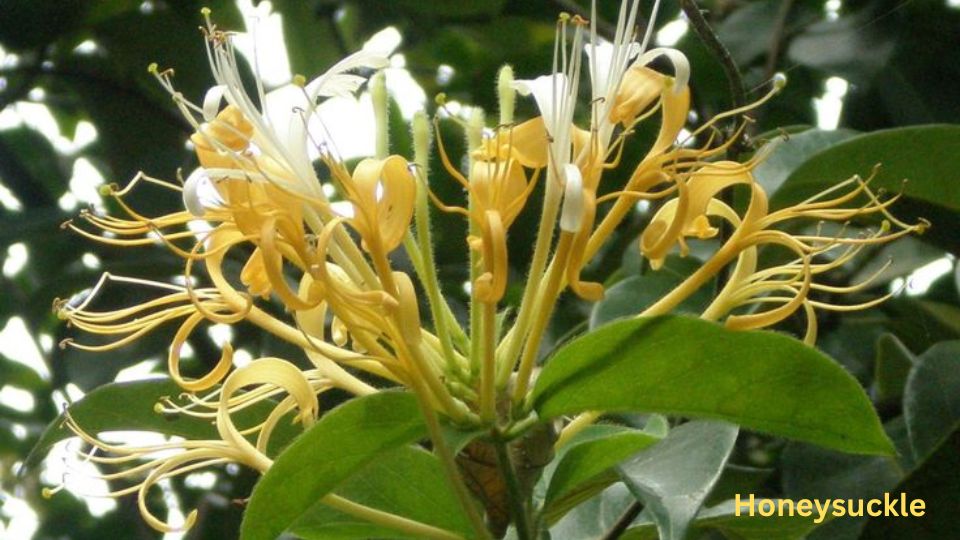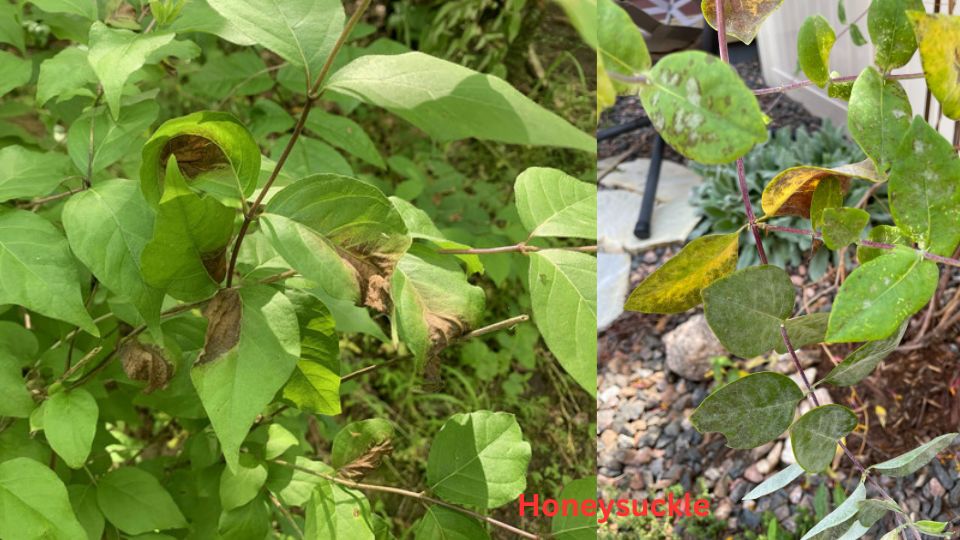No, it’s not normal to have brown honeysuckle leaves. ‘Why are my honeysuckle leaves turning brown?’ people then ask.
The answer is honeysuckle leaves can turn brown due to various reasons, including underwatering, overwatering, nutrient deficiencies, extreme temperatures, fungal diseases’, pest infestations, and root damage.
Let’s get into the details in the following sections.
Is It Normal for Honeysuckle Leaves to Turn Brown?
It’s not usually normal for honeysuckle leaves to turn brown, at least not during the active growing season. Brown leaves often signal that something’s wrong. It could be due to watering issues, pests, disease, or even stress from weather or poor soil conditions. If your plant is otherwise healthy and thriving, a few brown leaves here and there might not be a huge concern.
That said, some browning can happen naturally in the fall or winter, especially with deciduous varieties. In colder climates, leaf drop or color change is part of the plant’s seasonal cycle. If it happens suddenly or spreads quickly, though, that’s a sign to take a closer look.
So while occasional browning can be seasonal or minor, persistent or widespread leaf browning usually means your honeysuckle needs some attention. Spotting the cause early can help you get it back on track fast.
Reasons Why Honeysuckle Leaves Turning Brown
Honeysuckle leaves can turn brown due to various reasons, which are often related to environmental stress, disease, or pest infestation. Here are some common reasons why honeysuckle leaves may turn brown:
- Watering Issues: Underwatering or overwatering can cause stress to the plant, leading to browning of leaves. Too little water can lead to dehydration, while too much water can suffocate the roots, causing root rot and impairing the plant’s ability to take up nutrients.
- Soil Conditions: Poor soil drainage can contribute to waterlogged roots, leading to root rot and brown leaves. Additionally, nutrient deficiencies or imbalances in the soil can cause leaf discoloration.
- Environmental Stress: Extreme temperatures, especially heatwaves or cold snaps, can stress the plant and cause browning of leaves.
- Pest Infestations: Insects like aphids, spider mites, or scale insects can feed on honeysuckle leaves, causing damage and discoloration.
- Improper Pruning: Incorrect pruning techniques or pruning at the wrong time of year can stress the plant and lead to leaf browning.
- Chemical Exposure: Exposure to herbicides, pesticides, or other chemicals can cause leaf burn and discoloration.
- Drought Conditions: Prolonged periods of drought can stress the honeysuckle plant and cause leaves to turn brown.
- Nutrient Deficiencies: Lack of essential nutrients, such as nitrogen, iron, or magnesium, can result in leaf discoloration and browning.
- Root Damage: Physical damage to the roots, such as during transplanting or construction work, can lead to stress and browning of leaves.
If the problem persists or worsens, it’s advisable to consult a local horticulturist or gardening expert for further assistance.
Jewel Orchid Leaves Turning Red, you can read that article, as I assume it can help if you have Jewel Orchids.
Problems and Solutions at A Glance: Honeysuckle Leaves Turning Brown
Here is a problem and solution table on honeysuckle leaves turning brown:
| Problem | Solution |
| Underwatering | Increase watering frequency and ensure soil moisture. |
| Overwatering | Adjust the watering schedule and improve soil drainage. |
| Poor soil drainage | Amend soil or consider transplanting to a better location. |
| Nutrient deficiencies | Apply appropriate fertilizer or compost. |
| Extreme temperatures | Provide shade or protect from harsh weather conditions. |
| Fungal or bacterial | Apply appropriate fungicides or treatments. |
| Pest infestations | Use insecticidal soaps or pesticides as needed. |
| Improper pruning | Follow correct pruning techniques and timing. |
| Chemical exposure | Avoid using harmful chemicals near the plant. |
| Drought conditions | Increase watering during dry periods. |
| Root damage | Handle roots carefully during transplanting or digging. |
What to Do When Honeysuckle Leaves Turning Brown
When you notice that honeysuckle leaves are turning brown, it’s essential to take action promptly to address the issue and help the plant recover. Here are the steps you can take:
Step 1: Inspect the Plant
Thoroughly examine the affected honeysuckle plant to identify the extent of the browning and to look for any signs of pests, or other issues.
Step 2: Adjust Watering
Check the soil moisture regularly and adjust watering as needed. If the soil is dry, increase watering frequency, and if it’s waterlogged, improve drainage to prevent root rot.
Step 3: Improve Soil Drainage
If the plant is in poorly draining soil, consider amending the soil with organic matter or, if feasible, transplant the honeysuckle to a location with better drainage.
Step 4: Compost
Apply a balanced fertilizer or compost to provide the plant with essential nutrients. Nutrient deficiencies can cause leaf browning, and fertilization can help correct this issue.
Step 5: Provide Shade
If the browning is due to extreme heat or sun exposure, provide shade to protect the plant from harsh weather conditions.
Step 6: Treat for Diseases
If you suspect a fungal or bacterial disease, apply appropriate fungicides or treatments as recommended by a local gardening expert. Or check if honeysuckle leaf blight treatment is required.
Step 7: Control Pests
If pests are infesting the plant, use insecticidal soaps or pesticides to control them. Be sure to follow the instructions on the product label.
Step 8: Prune Carefully
If you need to prune the honeysuckle, do so carefully and follow proper pruning techniques. Avoid pruning during stressful periods for the plant.
Step 9: Avoid Chemical Exposure
Prevent chemical exposure near the plant, as it can lead to leaf burn and browning.
Step 10: Increase Watering During Drought
In periods of drought, make sure the honeysuckle receives sufficient water to prevent stress and leaf browning.
Step 11: Handle Roots with Care
If you’re transplanting or doing any construction work near the plant, be gentle with the roots to avoid damage.
Step 12: Monitor Progress
After implementing the necessary steps, keep a close eye on the plant’s condition. If the browning persists or worsens, seek advice from a local horticulturist or gardening expert for further assistance.
Remember, it’s crucial to address the underlying cause of the honeysuckle leaves turning brown to ensure the long-term health and vitality of your plant. Early intervention and proper care can go a long way in helping the plant recover and thrive.
Preventing Leaf Browning in the Future
Once you’ve treated the browning leaves, the next step is making sure it doesn’t happen again. Prevention starts with consistent care. Water your honeysuckle regularly, but don’t let the soil become soggy. Use well-draining soil to avoid root rot, and add mulch to retain moisture during hot weather.
Feeding your plant with a balanced fertilizer once or twice during the growing season can also help keep leaves healthy. Watch for early signs of pests like aphids or mites, and treat them right away with insecticidal soap if needed. Avoid pruning during extreme weather or growth periods; do it after flowering to reduce stress.
Also, try to plant honeysuckle in a spot with good sunlight and airflow. This helps prevent fungal issues and supports strong growth. A little observation goes a long way. Regular check-ins can help catch issues early, so your honeysuckle keeps thriving season after season.
Honeysuckle Plant Maintenance Spots
Maintaining a honeysuckle plant involves regular care and attention to ensure its health and vitality. Here are some essential maintenance spots to focus on:
Watering
Adequate and consistent watering is crucial for honeysuckle plants. Water the plant deeply but avoid waterlogging the roots. During dry periods, increase watering frequency to prevent stress and leaf browning.
Soil Drainage
Ensure that the honeysuckle is planted in well-draining soil. Poor drainage can lead to root rot and other issues.
Fertilization
Apply a balanced fertilizer or compost during the growing season to provide essential nutrients to the plant.
Pruning
Regular pruning is essential for honeysuckle plants. Prune the plant to shape it, remove disordered wood, and encourage new growth. Pruning also helps to control the size of the plant and promotes flowering.
Support Structure
Honeysuckle is a climbing plant and requires support to grow vertically. Install a trellis, fence, or other support structure for the plant to climb.
Pest Control
Monitor regularly for signs of pests or honeysuckle vine diseases’. If you notice any issues, take appropriate measures to control them using safe and effective methods.
Mulching
Apply a layer of organic mulch around the base of the honeysuckle plant to retain moisture, suppress weed growth, and regulate soil temperature.
Sunlight Exposure
Ensure that the honeysuckle plant receives sufficient sunlight. Most varieties prefer full sun, but some may tolerate partial shade.
Winter Protection
In colder climates, protect the honeysuckle plant during winter by adding mulch around the base and wrapping it with burlap to shield it from extreme cold and harsh winds.
Regular Inspections
Regularly inspect the plant for any signs of stress, browning leaves, or unusual growth patterns. Early detection of honeysuckle plant problems allows for timely intervention.
Training Vines
If the honeysuckle is grown on a trellis or fence, guide the vines to encourage proper growth and coverage.
Prune After Flowering
For varieties that bloom on old wood, prune immediately after flowering to avoid cutting off next season’s buds.
Air Circulation
Ensure that the plant has adequate air circulation to reduce the risk of fungal diseases.
By paying attention to these maintenance spots, you can keep your honeysuckle plant healthy and vibrant, allowing it to thrive and produce beautiful blooms throughout the growing season.
FAQs
Can brown leaves on honeysuckle be salvaged?
In some cases, brown leaves can be salvaged by addressing the underlying issue promptly.
Depending on the cause, adjusting watering, providing proper care, and treating diseases or pests can help the plant recover and produce healthy new growth. However, severely damaged leaves may not recover.
Is it normal for honeysuckle leaves to turn brown in winter?
Yes, it is normal for some honeysuckle varieties to experience leaf browning in winter, especially in colder climates.
Some honeysuckle species are deciduous, and their leaves naturally change color and drop during the colder months. Proper winter protection can minimize stress on the plant.
How can I differentiate between nutrient-deficiency and pest infestation as the cause of browning leaves?
To differentiate between the two, closely inspect the leaves and stems. Nutrient-deficiencies usually result in uniform discoloration, while pests often leave distinct patterns like chewed edges or stippling marks.
Examining the underside of leaves for pests and consulting gardening resources can help identify the issue. Also, if you are facing problems with your orchids, then check out Orchid Roots Are Turning Brown.
Thank you for supporting us and always trying to keep yourself technologically updated.










